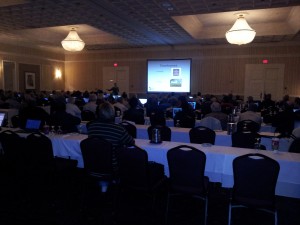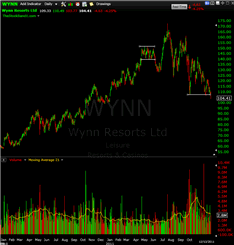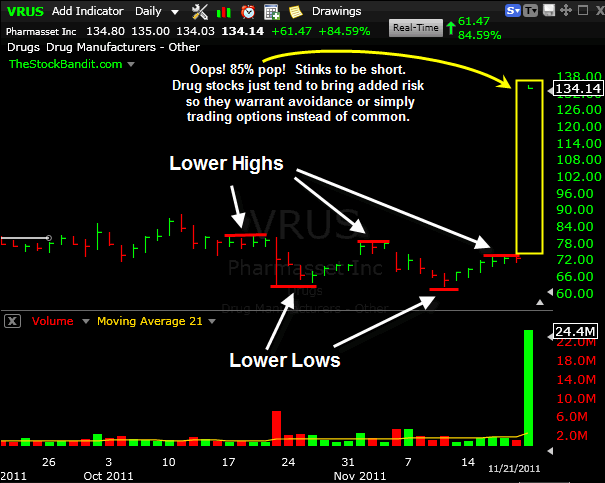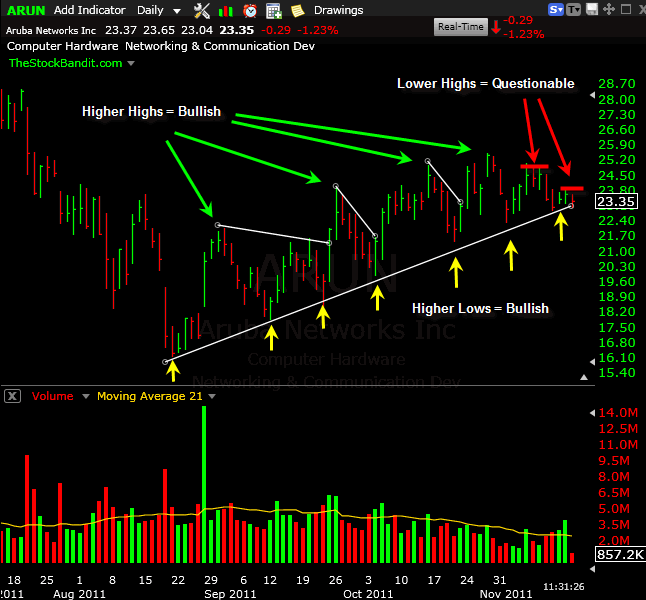Search Results for 'traders'
I Don’t Care How Fresh Your Fundies Are
I’m a trader, so what I care about is catching short-term moves in price. I’m not an investor who’s looking for long-haul appreciation or locating the next ORCL. For that reason, the health of a business doesn’t matter to me. It’s unlikely to change during the course of a trade that lasts anywhere from a few hours up to a couple of weeks (barring scheduled earnings reports or conference calls).
 Some traders fixate on fundamentals. They might use the fundies as a starting point for trade ideas, which is alright, but is not necessary for short-term positions. They might use the fundamentals as a logic crutch to defend their losing trade, telling themselves “it’ll come back” because of the business. We know how that usually ends for them when opinions are allowed to interfere.
Some traders fixate on fundamentals. They might use the fundies as a starting point for trade ideas, which is alright, but is not necessary for short-term positions. They might use the fundamentals as a logic crutch to defend their losing trade, telling themselves “it’ll come back” because of the business. We know how that usually ends for them when opinions are allowed to interfere.
If you haven’t already done so, make this all-important distinction: there are good companies and there are good stocks, and they do not necessarily overlap. Sorry if that bursts your bubble, but many great businesses have a stock that’s going nowhere. Some stocks are making excellent, clean moves even though their business may not endure the test of time. The correlation between good company and trade-worthy stock is not at all guaranteed.
Here’s the point in case you’ve missed it so far… If you are a trader, focus on the price action and place importance on it alone. Trading is about compounding money by turning capital over frequently. It’s not committing to a long-term relationship with a stock…that’s investing and it’s an entirely different topic (not found here).
So if you are a trader, and if your timeframe is less than a few weeks, consider the likelihood that the health (or lack thereof) of the company behind the ticker symbol you’re trading just isn’t going to change that quickly. Business growth or attrition takes time. With that in mind, all you’re left with is the price action – right where we began.
Simple and straightforward.
Trade Like a Bandit!
Jeff White
Producer of The Bandit Broadcast
Follow TheStockBandit on Twitter or get our free newsletter to keep up!
Hoping to See You in 2012
 This past weekend I had the pleasure of doing some live training in conjunction with Worden, and I thoroughly enjoyed it. Getting to teach a couple hundred traders in a seminar setting was a treat (I’m standing in the front of the room in this pic), and it was fun to cover a lot of ground on all things trading.
This past weekend I had the pleasure of doing some live training in conjunction with Worden, and I thoroughly enjoyed it. Getting to teach a couple hundred traders in a seminar setting was a treat (I’m standing in the front of the room in this pic), and it was fun to cover a lot of ground on all things trading.
We discussed key principles of trade selection, a trader’s mindset, and how to prepare like a professional on a regular basis. Then we built a watch list together with attendees offering up their favorite tickers, spouting them off popcorn-style as I added them to the list. From there, we just analyzed the price action to see what the charts were telling us. When you listen, the charts tend to have a lot to say!
Anyway, I’m slated to teach and/or speak live in several more cities in 2012, and I hope to see you at some point. Houston in Feb, NYC Trader’s Expo in Feb, Atlanta in March, and Denver in June are currently on the calendar. Make plans to attend one of these cities and I will do my best to make it worth your while.
To those who were in Dallas last weekend, I hope you enjoyed it as much as I did!
Trade Like a Bandit!
Jeff White
Producer of The Bandit Broadcast
Follow TheStockBandit on Twitter or get our free newsletter to keep up!
Trading Timeframe Influences Position Size
 Equally important to locating entries and exits is the matter of sizing your positions. Too much and you can’t stick with the trade plan, aborting in favor of diminishing emotions (whether greed or fear). Too little and you don’t maximize the use of your capital.
Equally important to locating entries and exits is the matter of sizing your positions. Too much and you can’t stick with the trade plan, aborting in favor of diminishing emotions (whether greed or fear). Too little and you don’t maximize the use of your capital.
While some traders prefer a standard lot size, in this video I’ll discuss the notion that your timeframe for the trade should influence your position size.
Yes, the chart itself will help determine your exits, but that’s also a function of how long you’ll expect to be in the trade.
Check out the video for a quick 5-minute explanation and you’ll see exactly what I mean.
(Direct video link is here for those interested in sharing).
Be sure to view in HD (720P) and full-screen mode for best quality in the video.
Trade Like a Bandit!
Jeff White
Producer of The Bandit Broadcast
Follow TheStockBandit on Twitter or get our free newsletter to keep up!
A Trader’s 5-Step Recovery
re-cov-er-y (noun) – the regaining of something lost or taken away; restoration to a former or better condition; the extraction of useful substances from waste.
Traders have to go through recovery on almost an ongoing basis. Sometimes it’s from a paper-cut-sized hit to the account, while other times it involves coming back from an amputation of sorts – whether it be a major drawdown to actual or emotional capital.
 Either way, without the ability to recover, you’re done. (Obvious alert: that’s no place to be).
Either way, without the ability to recover, you’re done. (Obvious alert: that’s no place to be).
There are steps to recovery which should be taken, and I want to discuss some of them. By no means is this an exhaustive list, so please add your own in the comments, but here are a few which I think are necessary on the (sometimes long) road back.
Admit it. Face up to what it is. Call it a slump, call it shattered confidence, call it a big scary market monster. Whatever “it” is, you have to get it on the table so you can deal with it.
Seek help. Maybe you shouldn’t go it alone. Without some accountability, it’s easy to relapse. Find a mentor or some coaching to get you back on track, and add some skills to your repertoire. The fact of the matter is that left to your own abilities as they currently stand, you may very well be facing a similar situation again.
Take inventory. Take an inventory of what’s left of your capital, both in terms of cash and confidence. It may be that you simply don’t have enough left to consider a comeback right away, so perhaps you incubate for awhile and prepare in other ways for your eventual return. Or perhaps you assess your situation and realize you have more than enough to start the process.
Get uncomfortably familiar with the cause. What was it that put you in need of recovery to begin with? Overconfidence? Lack of respect for the market? A series of small mistakes which compounded your problems? Understanding the root cause of your wounds, even if painful, will help you prevent it from happening again in the future. After all, you’ve already paid the tuition, you might as well get the lesson.
Get back in the saddle. The last step in the sequence is to return to trading and begin rebuilding. Start thinking about what that’s going to look like for you and how you’ll avoid the same pitfalls which got you this time around. Visualize yourself back in the routine again, making plays, staying disciplined, and having success.
** What are some steps you think are necessary to begin the healing process following a big trading loss?
Trade Like a Bandit!
Jeff White
Producer of The Bandit Broadcast
Follow TheStockBandit on Twitter or get our free newsletter to keep up!
6 Must-Have Trading Books
I was asked this week about the best trading books from a trader who expects to have some downtime this winter due to his seasonal business. Here’s the list I sent him.
Market Wizards, New Market Wizards, Stock Market Wizards, all by Jack Schwager. These are interview-style books loaded with insights from traders of all styles and in all markets. Must-have books.
Reminiscences of a Stock Operator by Edwin Lefevre. This classic is a memoir-type book modeled after Jesse Livermore, one of the most famous traders ever. Underline the lessons that stand out to you, but it’s full of wisdom even though it’s approaching 90 years old.
The Zurich Axioms by Max Gunther. A list of rules from Swiss bankers which is apply for any trader. A little harder book to find, but a great one worth reading multiple times.
How I Made $2 Million in the Stock Market by Nicolas Darvas. A true-life account (published in 1960) of a guy who made every mistake imaginable before finding his winning system. It’s got a lot of great lessons and it’s one I’ve read numerous times for that reason.
All these are great aids for traders, they are not how-to books but rather the kinds of books with lessons that last. I’d recommend them all!
UPDATE: Somehow I left off the newest book worth reading, which is One Good Trade by Mike Bellafiore. I reviewed it earlier this year and have re-read it since, it’s that good. Somehow in writing this post, I was fixated on older books but this should have been a post on 7 Must-Have Trading Books!
Trade Like a Bandit!
Jeff White
Producer of The Bandit Broadcast
Follow TheStockBandit on Twitter or get our free newsletter to keep up!
Why I’m Careful Trading Drug Stocks
I’m really careful with trading drug stocks, there’s just so much to them. You have things to consider like FDA approvals, patient trials, lawsuits, huge news of positive or negative test results, etc. It can get to be a mess, and very few of those items are scheduled news, so they’re usually surprises.
That might sound exciting to some, but any veteran trader like me would tell you that surprises are not what a trading career is built on. Surprises spook us, and full-time traders like me want only to avoid them.
Take the buyout news in VRUS, for example, which sent the stock higher on Monday to the tune of 85%. Catching a pop like that doesn’t sound so bad, right?
Well, considering that technically the stock was set up better for a short than a long, the technical play wasn’t to be long over the weekend. The daily chart had shown both lower highs and lower lows in recent weeks. Those short would have effectively lost their entire position. Ouch!
Among other (more important) things this week, I’m thankful I had no position to begin with, but I just couldn’t help but notice the outsized gap on Monday morning.
Risk in market is required to profit, but great traders identify ways to reduce risk. Buyouts aren’t easy to see coming, but drug stocks just have too much other stuff going on anyway.
Bottom line: drug stocks are very tricky when it comes to overnight trades, so be consider the VRUS move another reason to be careful if you’re trading them (and consider options instead of common).
Here’s a closer look at the chart:

Trade Like a Bandit!
Jeff White
Producer of The Bandit Broadcast
Follow TheStockBandit on Twitter or get our free newsletter to keep up!
Detecting Subtle Changes of Character
As traders, it’s imperative that we take note of any nuance or variation from character when reviewing charts. Doing so can give us occasional false or contradicting signals, but it can also alert us to imminent moves or potential pattern failures.
Take for example those imminent move alerts. A sudden perk in volume as a stock turns to challenge a key level can sometimes be an indication that a breach of that zone is about to take place. Someone’s accumulating shares ahead of the break, and technical traders will take note of the volume expansion ahead of a possible break, placing that stock on the radar of many.
Deteriorating Demeanor
Potential pattern failures can also come to light sooner by taking note of variations in how the stock is moving. With that in mind, let’s examine a stock which may be giving off some of these subtle suggestions like I’ve been discussing.
ARUN has a multi-month uptrend line (higher lows) which has provided support on numerous occasions, letting dip-buyers use it as support to play short-term bounces. It’s still intact, but something else is of concern.
Specifically, the stock had been establishing higher highs along the way up, with each bounce attaining new recovery highs – until recently. Over the past couple of weeks, we’ve seen bounces carry to lower levels, and one could even consider drawing a rounded top around the peaks of the past month. This suggests waning strength in the stock, so I’d avoid a support-based buy at this point. ARUN may rally again from this area, but I’m not betting on it.
A New Plan
My inclination would be to give this one a bit more time and see if another descending trend line can be drawn at some point from the 10/27 peak along the recent highs and wait for an upside break. This stock has a history of clearing such trend lines (including the 3 drawn below), so that’s likely a better approach for getting long than a support buy after the establishment of lower highs.
Here’s a closer look at the chart:

Again, detecting these subtle variations in the price action is not a guarantee for better entries and exits. What it does is alert us to potential changes of character so we can make better decisions based on probabilities – and trading is all about probabilities.
Trade Like a Bandit!
Jeff White
Producer of The Bandit Broadcast
Follow TheStockBandit on Twitter or get our free newsletter to keep up!





